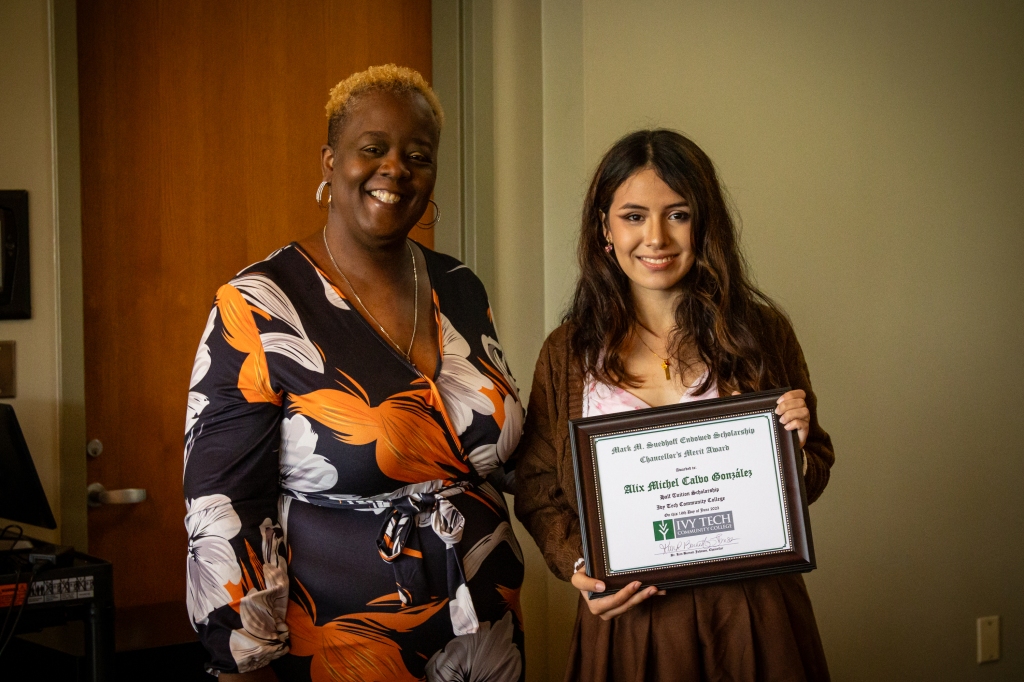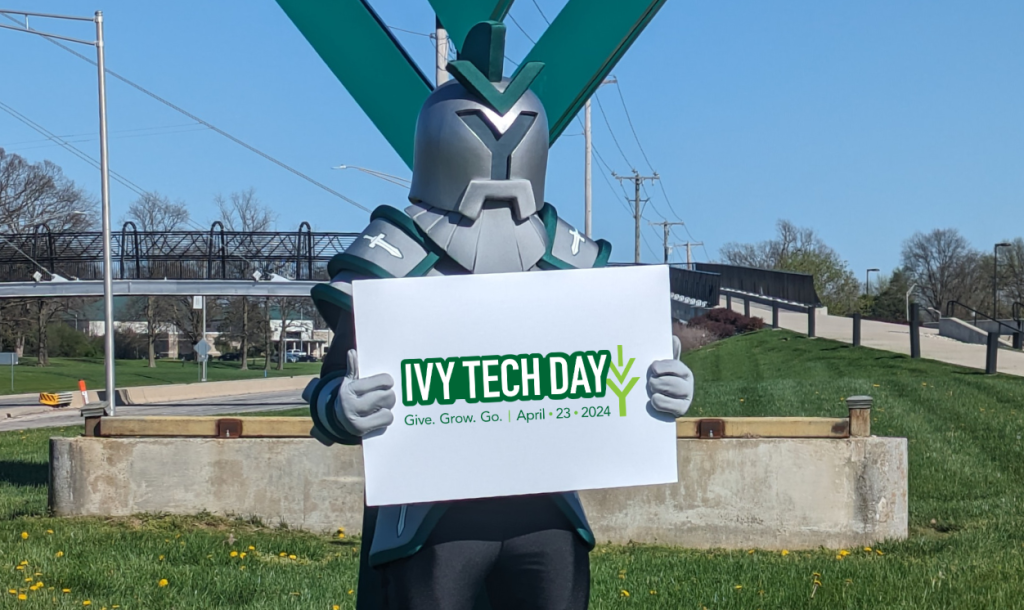Visual communications program chair one of the original Fort Wayne Derby Girls
The bout was held in a side arena at Memorial Coliseum. The floor was concrete, and attendees buzzed around tables selling swag and popcorn.
The stands? Well, they were packed. Absolutely filled with spectators of every age, from punk rock little girls to seniors with canes.
The scene: Fort Wayne Derby Girls vs. Derby City Roller Girls, from Louisville, Ky.
Truth-telling time: It was this girl’s first foray into derby, second if you count the hour-long interview with Erin Salyers, Ivy Tech Northeast’s program chair for visual communications and current derby girl. Though any verbal descriptions can’t quite come close to the power a spectator sees on the track. It is, simply, rad.

Derby rules
Derby works something like this:
Each game is made of two 30-minute periods, and each period is made of jams that last two minutes or less. The players—one jammer and four blockers per team—start on the track, which is flat and oval-shaped. When the jam begins, each team’s jammer works to get through the pack. The jammer who breaks out first is the lead jammer, who can begin scoring points on her second lap. Jammers score by passing opposing players. The blockers try to prevent the other team’s jammer from passing anyone and scoring. The lead jammer has the ability to call off the jam before the two-minute timeframe. She might choose to do this if the other team’s jammer is in a position to pass other players, which would score her team points.
As a spectator, it looks like this: a group of 10 women are bunched together skating, and two, often little, speedsters break away, sometimes tiptoeing on their skates’ front breaks like rebel ballerinas. They zoom around the track while the rest of the pack holds back, often facing each other and gripping one another’s forearms to create a sturdier barrier than one woman alone, to better stop the other team’s jammer from passing anyone.
“There are seven refs in every game,” Salyers says. “One ref per jammer, just counting points of who they pass. Then they have five other refs watching for penalties and blowing whistles for the jam to start.”
Salyers, the derby girl

In the derby world, Salyers is known as “Boomerang.” Players choose pseudonyms and are known by them on the team and throughout the league.
“Most everyone calls me ‘Boom,’” she says. “If someone calls me ‘Erin,’ they’re like, ‘Who?’”
In 2005, roller derby underwent a revival, Salyers says. In the game she remembers as a kid, tracks were banked and bouts were scripted, like wrestling. Derby girls in the 1970s learned to play by learning to fall, which drew a crowd.
Eventually, derby died out, and attempted revivals over the years never stuck, until the early 2000s.
“They rewrote the rules to make it a real sport instead of scripted,” Salyers says. “They figured out how to make the track on a flat surface. Then you could tape down rope anywhere, and you could have a roller derby track.”
Two Fort Wayne women saw a derby bout on vacation one day in 2005, and they decided to bring it to Fort Wayne, Salyers says. They recruited a couple friends to join but needed more team members, so they papered the city with fliers in restaurants, record stores, and bars—which Salyers saw. She remembers thinking, “I don’t know what this is, but I’m doing this.” She’d always been into physical sports as a kid, and she knew how to skate, so derby seemed like a perfect fit. Salyers was one of the first members who hadn’t been specifically recruited by friends.
“Boom is always team-oriented and a fierce competitor,” says Jolie Walker, a Derby Girl who has known Salyers for three years and goes by the name “Rachel Tension.”
Walker describes Salyers as caring, creative, and hard-working. The two are friends who often travel together to away games.
“I joke about the Boomerang always getting back to where it started,” Walker says.
This includes returning to the squad: Salyers left derby in 2007 when she had her first daughter, Everly. Six weeks after Everly was born, Salyers returned to practices and played a game eight weeks after giving birth.
Her return, however, didn’t work out.
“The time I wanted to commit to (derby) and the time it took were not aligning,” she says.
She had another daughter, Viola, in 2010. Salyers volunteered for the organization and stayed involved, but she missed derby and skating.
Eventually, when her daughters were old enough, Salyers realized she could tuck them into bed and have time to go to practice. She made her return as a player in 2015.
“The skating part was definitely like riding a bike, but the game, because it’s still a young sport, had advanced so much since I’d left. I had to learn a new rule set,” Salyers says. “It took me a good few games to not get penalties.”

Injuries
In Salyers’ off-time, many of those rule changes made the game less physical, and penalties are no longer called so loosely, which she doesn’t necessarily like.
“Back in the day, lunging was fun,” she says. “You can’t trip, clothesline, or punch, but you also can’t skate out of bounds, and you get hit off the track a lot. You also can’t grab onto teammates and create an impenetrable wall. The only areas where you can hit someone on other team is shoulder, hip, side.”
Her two big injuries did happen during her first few years with derby, before her daughters were born and before the rule changes: The first year she played, she broke her tailbone at practice.
“I was jamming, and someone pushed me,” she says. “I had to sit on a doughnut at work. I’d carry it around. My husband was in a band and would play in bars, and I’d have to carry it around with me. People started signing it.
“The first game after my tailbone, I was so paranoid about breaking it again, I was falling weird, and I broke my arm in the middle of the game.”
But she didn’t realize she’d broken it, so she played the rest of the game. After, when the adrenaline was gone, as the players congratulated each other, she realized the injury might have been worse than she thought after someone gave her a high five and pain radiated up her arm.
She still went to the after party.
The next morning, her arm throbbing, Salyers went to the doctor. She got a cast and was out for a few months.
Despite the potential injuries, Salyers persists, happily.
“It’s great stress relief, the camaraderie with the other skaters, being on a team,” she says. “You kind of lose that when you’re an adult. No matter what’s happening with work, kids, family, whatever, I can go to practice at night and forget everything.”
Congrats, students!
In February, Fort Wayne’s American Advertising Federation awarded six Ivy Tech Northeast students 11 awards for their graphic and illustrative artwork. Five of those students study with Visual Communications Program Chair Erin Salyers.
Those students are, from left (below): Jordan Krieger, Gabi Pfeiffer, Salyers, Joe Wood, and Marianne Bay. Not pictured are Stephanie Petras and James Fazzaro, a computing and informatics student who does videography and photography on the side. He saw a flier advertising the awards and asked Salyers if he’d be able to submit something, too.






